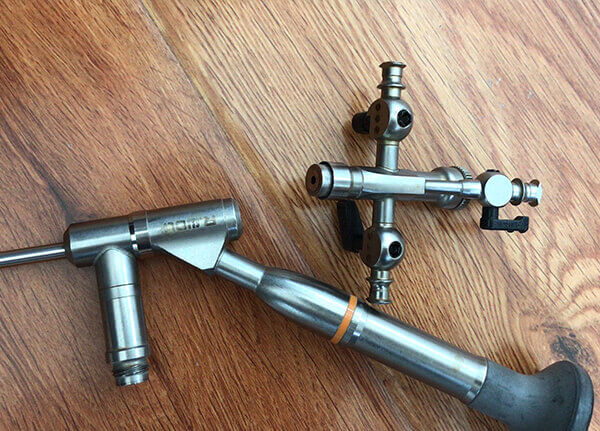欢迎来到匠仁医疗设备有限公司网站!

内窥镜设备凭借精密的光学与电子系统,成为医疗诊断、工业检测等领域的 “透视眼”。但在维修过程中,稍有不慎就可能引发二次损坏,让原本的故障 “升级”。从拆解到组装,从检测到调试,每个环节都暗藏风险。掌握科学的维修方法,才能避开这些 “雷区”,让设备安全 “康复”。
Endoscopic equipment, with its precise optical and electronic systems, has become the "see through eye" in fields such as medical diagnosis and industrial testing. But during the repair process, even a slight carelessness may cause secondary damage, upgrading the original malfunction. From disassembly to assembly, from testing to debugging, every step carries hidden risks. Mastering scientific maintenance methods is necessary to avoid these "minefields" and ensure the safe "recovery" of equipment.
拆解环节:像 “拆钟表” 般小心翼翼
Disassembly process: Be cautious like dismantling a clock
拆解是维修的第一步,却也是最易引发二次损坏的阶段。内窥镜内部结构精密,镜头、光纤、电路板等部件微小且脆弱,暴力拆卸可能导致镜头碎裂、光纤折断或线路焊点脱落。正确做法是先查阅设备手册,了解各部件连接方式与固定位置,使用专用工具(如微型螺丝刀、镊子)精准操作。例如,拆卸镜头时,需避免触碰镜面,防止留下指纹或划痕;分离光纤束时,不可过度弯折,应顺着其自然弯曲方向轻轻分离,避免因应力集中导致断裂。若遇到顽固部件,可使用专用溶剂软化固定胶,切忌强行撬开。
Disassembly is the first step in maintenance, but it is also the stage that is most prone to secondary damage. The internal structure of endoscopes is precise, and components such as lenses, fibers, and circuit boards are small and fragile. Violent disassembly may result in lens breakage, fiber breakage, or detachment of circuit solder joints. The correct approach is to first consult the equipment manual, understand the connection methods and fixing positions of each component, and use specialized tools (such as micro screwdrivers and tweezers) for precise operation. For example, when disassembling the lens, avoid touching the mirror surface to prevent leaving fingerprints or scratches; When separating fiber bundles, they should not be excessively bent and should be gently separated along their natural bending direction to avoid breakage caused by stress concentration. If encountering stubborn components, special solvents can be used to soften the fixing adhesive, and do not forcefully pry it open.
清洁保养:杜绝 “温柔的伤害”
Cleaning and maintenance: eliminate "gentle harm"
清洁是维修的关键步骤,但不当操作反而会带来隐患。镜头、导光窗等光学部件对清洁要求极高,使用粗糙的擦拭材料或腐蚀性清洁剂,可能损伤镀膜,降低透光率。正确的清洁流程应从低风险方法开始:先用无尘气吹去除表面浮尘,再用镜头纸蘸取专用光学清洁剂,沿一个方向轻柔擦拭。对于管道内部,需使用与管径匹配的软质毛刷,避免刷头过硬刮伤内壁。此外,电子元件的清洁更需谨慎,严禁使用含水量高的清洁剂,可采用干燥的压缩空气吹扫,或使用专用电子清洁剂快速挥发去污。
Cleaning is a crucial step in maintenance, but improper operation can actually bring hidden dangers. Optical components such as lenses and light guide windows require extremely high cleaning standards. Using rough wiping materials or corrosive cleaning agents may damage the coating and reduce light transmittance. The correct cleaning process should start with low-risk methods: first, use dust-free air to blow away surface dust, then dip lens paper in specialized optical cleaner and gently wipe in one direction. For the interior of the pipeline, a soft brush that matches the diameter of the pipe should be used to avoid scratching the inner wall with a hard brush head. In addition, the cleaning of electronic components requires more caution. It is strictly prohibited to use cleaning agents with high water content. Dry compressed air can be used for blowing, or specialized electronic cleaning agents can be used for rapid volatilization and decontamination.

检测调试:警惕 “牵一发而动全身”
Testing and debugging: Be wary of the saying 'one pull can affect the whole body'
故障检测与调试阶段,错误的操作可能引发连锁反应。在未明确故障原因时,盲目通电测试可能导致短路,烧毁电路板;使用不匹配的检测设备,也可能因电压、信号干扰损坏敏感元件。因此,检测前需断开电源,使用万用表、示波器等工具进行静态测量,逐步排查故障点。调试过程中,应遵循 “循序渐进” 原则:从低功率、低强度的测试开始,例如调整光源亮度时,先调至最低档观察反应,再逐步升高,避免因瞬间强光冲击损坏导光纤维或图像传感器。同时,每次调试后需记录数据,便于追溯问题根源。
During the fault detection and debugging phase, incorrect operations may trigger a chain reaction. Blindly conducting power on testing without identifying the cause of the malfunction may result in a short circuit and burn out the circuit board; Using mismatched detection equipment may also damage sensitive components due to voltage and signal interference. Therefore, before testing, it is necessary to disconnect the power supply and use tools such as multimeters and oscilloscopes for static measurement to gradually identify the fault point. During the debugging process, the principle of "gradual progress" should be followed: starting from low-power and low-intensity testing, for example, when adjusting the brightness of the light source, first adjust it to the lowest level to observe the reaction, and then gradually increase it to avoid damaging the light fiber or image sensor due to instantaneous strong light impact. At the same time, data should be recorded after each debugging to facilitate tracing the root cause of the problem.
组装还原:细节决定 “成败”
Assembly restoration: details determine 'success or failure'
组装环节看似简单,实则暗藏风险。部件安装顺序错误、螺丝拧得过紧或过松,都可能影响设备性能。例如,镜头安装时若未对准定位槽,可能导致成像模糊;电路板固定螺丝过紧,会造成 PCB 板变形,引发线路断路。因此,组装时需严格参照维修手册,按标记或编号归位部件,并使用扭矩螺丝刀控制螺丝拧紧力度。此外,密封部件(如防水胶圈、密封圈)的安装至关重要,需确保位置准确、无扭曲变形,否则可能导致设备进水或气体泄漏,造成更严重的损坏。
The assembly process may seem simple, but it actually carries hidden risks. Incorrect installation sequence of components, over tightening or over loosening of screws may all affect equipment performance. For example, if the lens is not aligned with the positioning groove during installation, it may cause blurry imaging; Tightening the fixing screws of the circuit board can cause deformation of the PCB board and lead to circuit breakage. Therefore, during assembly, it is necessary to strictly refer to the maintenance manual, locate the components according to the markings or numbers, and use a torque screwdriver to control the tightening force of the screws. In addition, the installation of sealing components (such as waterproof gaskets and sealing rings) is crucial, ensuring accurate positioning and no twisting or deformation, otherwise it may cause water or gas leakage to the equipment, resulting in more serious damage.
人员与环境:筑牢维修的 “安全防线”
Personnel and Environment: Building a Secure Defense Line for Maintenance
避免二次损坏不仅依赖技术,还需重视维修环境与人员培训。维修区域应保持洁净、干燥,配备防静电工作台、接地手环等设施,防止静电击穿电子元件;温湿度需控制在适宜范围,避免因潮湿导致电路板受潮短路。维修人员需经过专业培训,熟悉设备原理与维修规范,严禁在不了解结构的情况下 “凭经验” 操作。同时,建立严格的质量检验流程,维修完成后需进行多轮测试,包括功能测试、密封性测试、图像质量检测等,确保设备恢复正常性能,无潜在隐患。
Avoiding secondary damage not only relies on technology, but also requires attention to maintenance environment and personnel training. The maintenance area should be kept clean and dry, equipped with anti-static workstations, grounding wristbands and other facilities to prevent static electricity from penetrating electronic components; The temperature and humidity should be controlled within an appropriate range to avoid short circuits caused by moisture on the circuit board. Maintenance personnel need to undergo professional training, be familiar with equipment principles and maintenance specifications, and are strictly prohibited from operating based on experience without understanding the structure. At the same time, establish a strict quality inspection process, and conduct multiple rounds of testing after maintenance, including functional testing, sealing testing, image quality inspection, etc., to ensure that the equipment returns to normal performance without potential hazards.
本文由内窥镜设备维修友情奉献.更多有关的知识请点击:http://www.jiangrenyiliao.cn我们将会对您提出的疑问进行详细的解答,欢迎您登录网站留言.
This article is a friendly contribution from the maintenance of endoscopic equipment For more information, please click: http://www.jiangrenyiliao.cn We will provide detailed answers to your questions. You are welcome to log in to our website and leave a message
 公司:匠仁医疗设备有限公司
公司:匠仁医疗设备有限公司 樊经理:13153199508 李经理:13873135765
公司地址:山东省济南市槐荫区美里东路3000号德迈国际信息产业园6号楼101-2室 湖南省长沙市雨花区劳动东路820号恒大绿洲14栋2409室
备案号:鲁ICP备2023027194号-1 鲁公网安备 37010402441281号